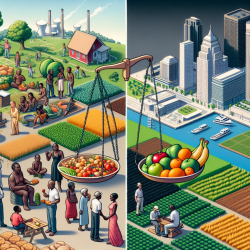Introduction
Food insecurity is a pressing public health issue in the United States, with racial disparities evident in many urban areas. The study titled Explaining Racial Inequality in Food Security in Columbus, Ohio: A Blinder–Oaxaca Decomposition Analysis provides valuable insights into the factors contributing to this disparity. This blog explores how practitioners can leverage these findings to improve their understanding and approach to addressing food insecurity among racial minorities.
Key Findings from the Study
The research conducted in Columbus, Ohio, highlights a significant gap in food security between Black and White households. A 34.2 percentage point difference was identified, with socioeconomic characteristics, food shopping behaviors, and neighborhood perceptions contributing to this gap. The Blinder–Oaxaca decomposition method was employed to analyze these factors, revealing that:
- Socioeconomic variables explained 63.1% of the food security gap.
- Food shopping behaviors accounted for 13.8% of the gap.
- Neighborhood perceptions contributed 11.6% to the disparity.
Implications for Practitioners
Understanding the multifaceted nature of food insecurity is crucial for practitioners working to alleviate this issue. Here are some actionable insights derived from the study:
- Focus on Socioeconomic Factors: Addressing income disparities and educational attainment can significantly impact food security. Practitioners should advocate for policies that promote economic equity and educational opportunities for minority communities.
- Enhance Transportation Access: The study highlights the importance of private vehicle access in food shopping. Programs that improve transportation options for low-income families can help bridge the food security gap.
- Strengthen Community Networks: Building strong social networks within neighborhoods can enhance food security. Community-based interventions, such as gardening projects and corner store enhancements, can foster social bonds and improve access to nutritious food.
Encouraging Further Research
While the study provides a comprehensive analysis of existing factors, there remains a portion of the food security gap unexplained. Practitioners are encouraged to explore additional variables and conduct further research to uncover new insights. Potential areas for exploration include:
- Structural racism and its impact on food access.
- The role of social capital and discrimination in food environments.
- Innovative community interventions that address both food access and social cohesion.
Conclusion
The study on racial inequality in food security in Columbus, Ohio, provides a critical framework for understanding and addressing food insecurity among minority communities. By focusing on socioeconomic factors, transportation access, and community networks, practitioners can make informed decisions to reduce disparities. For a deeper understanding of the study, practitioners are encouraged to read the original research paper.
To read the original research paper, please follow this link: Explaining Racial Inequality in Food Security in Columbus, Ohio: A Blinder–Oaxaca Decomposition Analysis.










